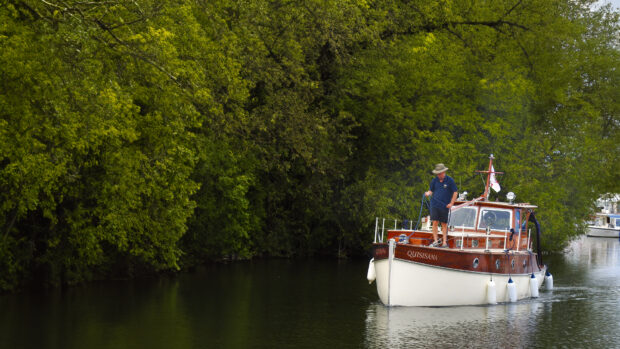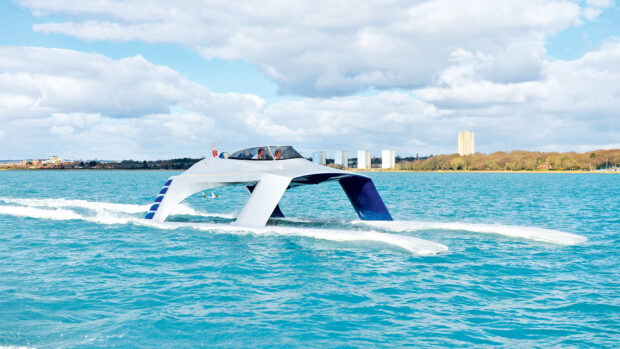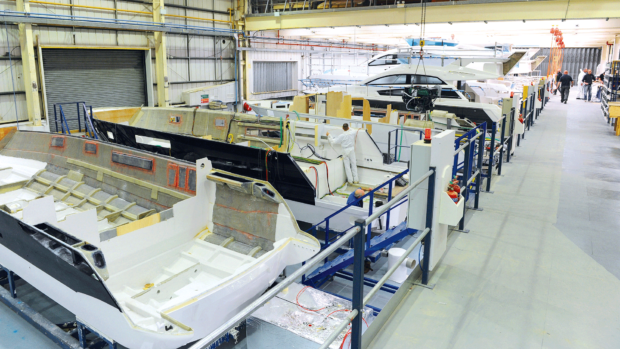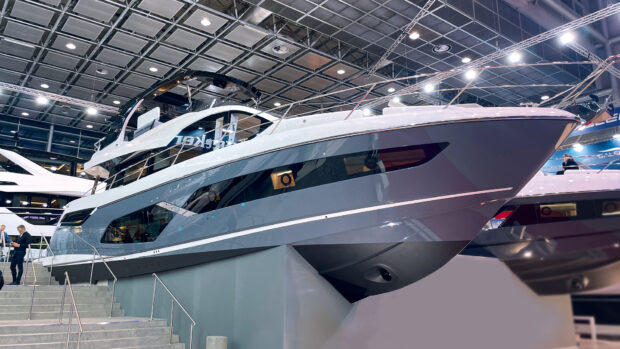Grandezza 40 owner Per Harrtoft is on a mission to cruise from his home on the south-east coast of Sweden to the Lofoten islands in the far north of Norway
After cruising solidly for two weeks, we have finally reached Bergen on my journey from Karlskrona in southeast of Sweden to Lofoten in the far north of Norway aboard our Grandezza 40 Fly, Deamare. I am 60 years old and although I have started to take life at a slower pace, I have only allowed two months for this 1,400nm trip, so when the weather permits I am making the most of my boat’s near 40 knot performance.
After a day in port, during which we saw a lot of Bergen and a lot of rain, it is time for a change of crew. Jørgen, an old friend of mine, has agreed to join me for the next three weeks before returning to Gothenburg.
After topping up the tanks, we head out of Bergen and push the throttles forward until we reach our cruising speed of 31 knots, where both the hull and the engines feel at their happiest. We drive north inside the island of Askøy and then slalom through the narrow straits west of Holsnøy and Radøy. The views are outstanding with immaculate houses perched on remote headlands or tucked deep inside bays like pearls in an oyster. There are even a few lighthouses standing proud on lonely, deserted islands. The one on Florøy is an absolute gem.
Mile after mile rolls under the hull and we are careful to change helmsman every hour to ensure we stay focussed at the wheel. When it’s time for lunch, we anchor in a sheltered bay near the tranquil village of Leirvik.
It’s tempting to stay for the afternoon but time is pressing on and so do we. After another long stint we finally arrive in Maløy, quietly satisfied with today’s haul of 114 miles.

Deamare safely moored-up in Maløy
Heeding a warning
We make our way towards the fuel dock, where a large bunker ship is already berthed. At the last moment Jørgen spots a blue rope lying across our path. Relieved not to have got it fouled around our props, we fill up the tanks, oblivious to the pouring rain, before docking in the guest harbour.
Walking along the pontoon we meet two Norwegians, who had suffered an engine breakdown on their way here in 6m waves and had to wait two long hours being rolled around in the swell before the sea rescue team could reach them. It is a sobering reminder of how challenging the conditions can be off the infamous Stad Peninsula, which is where we are heading tomorrow morning.

Arriving in Ålesund
Maløy to Kristiansund
With our grab-bags and survival suits at hand, we set off from Malǿy early the next morning. Skimming along at 37 knots we head out into the infamous Stad Sea. Once outside the shelter of the islands, the sea is as rough as expected, with waves of at least 3m. Luckily it’s a following sea and we can maintain a planing speed of 23 knots, increasing to 31 knots as we pass around the cape. Once past the final headland, we enter the more sheltered waters north of the Stad peninsula. Now, at last, we can slow down, exhale and celebrate with a traditional Swedish fika (coffee and cake).
After this challenging passage, we stay inshore, protected from the Atlantic by islands and skerries.
We stop in Ålesund for a quick lunch before continuing on through straits and fjords with fantastic views, until we reach Kristiansund – another long day and 135nm covered.

The lighthouse at Uthaug is magnificent
Kristiansund to Forvik
The waves follow us the next day, too, as we head out of Kristiansund and drive north through the archipelago. We cross paths with multiple commercial craft, from sizable freighters and salmon farm ships to small fishing boats.
Around 4pm, we start looking for somewhere to refuel and dive into Rørvik. Every harbour round here seems to have a fuel dock and sure enough we soon find one and top up the tanks while enjoying a fika before driving on.
This far north it stays light long into the night and we carry on cruising until we hit a new daily record of 213nm. Finally, at 8pm we turn into the small harbour of Forvik. We’re still a long way from Lofoten but now it is starting to feel closer.

A typical fishing vessel passes by on our journey north
Forvik to Røst
The following morning we awake to find mirror calm water surrounded by dramatic mountains soaring up into the clouds. We are far enough north now that even when the sun comes out it remains cool. Even without the warmth we are grateful for the weather windows that come with it and simply put on a sweater when necessary.
Today’s plan is to reach Bodø but then continue pushing on further north before making the crossing to Lofoten to reduce the length of the open water passage.
As soon as we are outside the harbour limits, I pin the throttle hard down and we power north at our maximum speed of 37 knots, cutting a white swathe across the dark, clear water.
Article continues below…

Lofoten or Bust: Taking a motor yacht to the far north of Norway
Passing the island of Vikingen, we see a steel monument shaped like a globe that tells us we are entering the Arctic Circle. From now on we will experience daylight 24 hours a day.
We press on through the archipelago, only making a short stop for fuel and lunch on the island of Bolga, 20 miles inside the Arctic Circle.
The conditions are so good and we are making such good progress that I suggest abandoning our original plan and cutting directly across to Røst, the outermost island group in Lofoten, instead. It is 50nm across open sea but if it stays this calm, it won’t take long. Jørgen agrees and before either of us succumb to second thoughts, I steer out into the North Sea towards Lofoten.
The swell starts to build as we leave the shelter of the islands but the wavelength is long enough for us to maintain a speed of 27 knots. After 90 mins or so a small speck appears on the horizon that grows in size as we draw closer.

It stays light long into the night and we carry on cruising until we hit a new daily record of 213nm
It’s the neighbouring island of Vaerøy whose high mountains are easier to spot than the lower-lying island of Røst. Before long, Røst appears. It is every bit as beautiful as expected and surrounded by countless small islands, none more than 11m high.
The Røst archipelago is a separate municipality to the rest of the Lofoten Islands comprising almost as many islands (640) as there are inhabitants (670). The main industry is fishing, most of which is air-dried for export.
There are few visiting boats at the guest dock so we have no trouble finding a berth alongside a pontoon and are soon met by the harbour master.
When we check the engines, we discover the drive belts for the superchargers on both engines have failed. They were new this season so it’s a mystery why they have worn through. The nearest Volvo Penta workshop is in Svolvear on Lofoten, so I’ll have to call them when they open tomorrow.
While the engine hatch is open, we lift out the two bikes we stowed there. Jörgen, who was an elite cyclist in his youth, takes the lead. Jackets, hats and mittens are needed in the cool weather, but it’s a great way to explore these remote islands. On our route we see countless drying racks, waiting for the next catch to come in. Time passes slowly here and neither the landscape nor the way of life seems to have changed much over the centuries. The island is flat, enabling us to keep up a good pace, and once we’ve seen everything there is to see, we return to the boat.

Traditional wooden fishing vessel in Röstmemon
Røst to Vaerøy
It’s a surreal feeling to wake up in Lofoten, after 18 months of planning. I’m excited to start exploring more islands but first I have to call the Volvo Penta workshop in Svolvaer to check the boat is still safe to use. They confirm that it is fine and book us in for the new belts to be fitted in four days time. Perfect, we now have time to enjoy Lofoten at our leisure.
It is a magical sight leaving the harbour and seeing all the low, flat islands emerging from a calm sea like blobs of pancake batter in a giant frying pan. Long swells lift and lower us as we cruise the 23 miles to the next big island of Vaeröy. To our surprise there is already a Swedish sailing boat in the harbour.

Deamare and Deamini dwarfed by the mountains in Måstadviken
The area around the harbour is flat but a few kilometres further out, the mountains rise steeply. Fish-drying racks dominate every square inch of free space and the smell of dried cod hangs in the air. Most of the houses here are made of wood and painted the same shade of white. Like everything here they are built to last and lovingly maintained.
Once again we wheel out our bikes to explore the island. The long days mean time is not an issue so we stick a picnic in our backpacks and stay out well into the evening.
Vaerøy to Ramberg
The following day dawns bright and sunny and after a short cruise south to the nearby bay of Måstadviken, we drop anchor in 8m of water as still and clear as a bottle of Bombay Sapphire. We launch our inflatable tender, Deamini, for a trip to the beach.
The view is magical, with the turquoise waters framed by sandy beaches and mountains that soar up into the cloudless sky. There isn’t another soul in sight and we spend the afternoon wandering along the beach and checking out some caves. When we head back to the boat, the breeze has picked up and we get soaked by the breaking waves. By the time we reach Deamare we are already so wet that we decide to take a quick dip. It may look the same colour as the Caribbean but at only 11°C, it certainly doesn’t feel like it!

Jörgen at the helm, north of Vaeröy
The sun is still shining brightly from a clear blue sky, and after weighing anchor we motor to the opposite side of the bay and follow the fairway that hugs the west coast of the island. The drop off here is so deep that at times we can almost reach out and touch the rocks. We carry on round the north side and then hop across to the next island, Ramberg, where we hope to experience the midnight sun.
After mooring and making ready, we have dinner at the campsite restaurant with a panoramic view of the beach. I even try the local delicacy, cod tongue, but I can’t pretend I enjoy it very much!
As midnight approaches, we walk along the beach with a French couple we met in the harbour. There are no clouds in the sky, so we enjoy a flawless view of the midnight sun as it clips the horizon directly outside the bay. It’s a major event here, with lots of people roaming around and joining in the fun.
In the early hours, we take refuge on the flybridge for one last nightcap, raising our glasses to the night-time sun.

Dreaming on the beach at Måstadbay
Ramberg to Ballstad
To our surprise, we wake up the next morning to rain and wind. After last night’s escapades, we settle for a gentle wander into town to buy gifts for home and some fishing tackle. In the afternoon we cast off and head south along the fjord that cuts through the larger islands. There we continue west along Moskenesǿya until we reach Reine, where we book a berth on the pier and fill up with the most expensive diesel so far. Reine is the main town in Moskenes municipality, even if only 300 people live here.
Being connected to the mainland, there are many more tourists here and after our usual cycle ride around the area we stop off at a pub near the boatyard for a much-needed beer. As the evening wears on, the sky clears and once again we get a fine view of the midnight sun as it shimmers above the low mountains north of us.

Moored in Ramberg
The following morning, I skip my usual workout and instead we pedal off on our bikes to the Reinebringen mountain, which we plan to climb despite my fear of heights.
The peak is at 1300m with a 400m climb from the road to the summit. Thankfully, the path up is paved with large rough-hewn granite steps rather than the slippery track I’d feared we’d encounter. After an hour and ten minutes of climbing we reach the top and are rewarded with a fantastic panoramic vista of the sea, the fjord and Reine. We can even see Deamare.
After recovering from our excursion, we set off that same day on the 15-mile cruise east to Ballstad. Here the Kymmerviken hotel has its own little marina and after a good dinner in the restaurant, we take advantage of the never-ending daylight to take our bikes out for an evening ride around Ballstad.

Jörgen and Per take a well-earned rest at the top of Reinebringen
Ballstad to Svolvaer
Later that night the wind picks up and when we leave Ballstad the next morning, we are greeted by big waves. By steering an eastern course, we keep the waves on our stern and maintain a relatively comfortable, if rather winding, 26-knot cruise. After a little less than 90 minutes we arrive in Svolvaer and dock in one of the workshop’s berths.
A mechanic cleans the remains of the broken drive belts from the cogs but discovers that one of the gears for the supercharger on the port engine also needs replacing, which they arrange to be air-freighted from Bodø the following day.
As it’s due to rain all day tomorrow, we’re not too bothered. Svolvaer is the capital of Vågan municipality and the centre of the Lofoten archipelago, so a day spent exploring the island by car is no big loss and there is plenty left to see once the engines are fixed.
Read the first part of this feature
Next month: Per and Jörgen continue their journey through the Lofoten archipelago to Bodö before tackling the infamous Saltstraumen tide race en route to Trondheim.
 If you enjoyed this….
If you enjoyed this….
Motor Boat & Yachting is the world’s leading magazine for Motoryacht enthusiasts. Every month we have inspirational adventures and practical features to help you realise your sailing dreams, as well as tests and news of all the latest motorboats.
Plus you’ll get our quarterly Custom Yachting supplement where we share the last on offer in the superyacht world and at the luxury end of the market.
Build your knowledge with a subscription delivered to your door. See our latest offers and save at least 30% off the cover price.



 If you enjoyed this….
If you enjoyed this….





